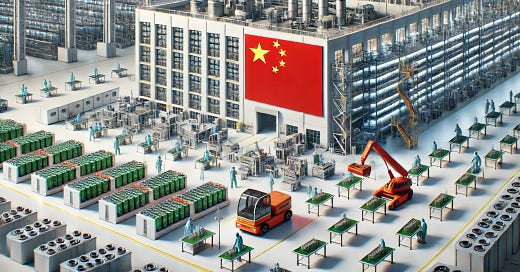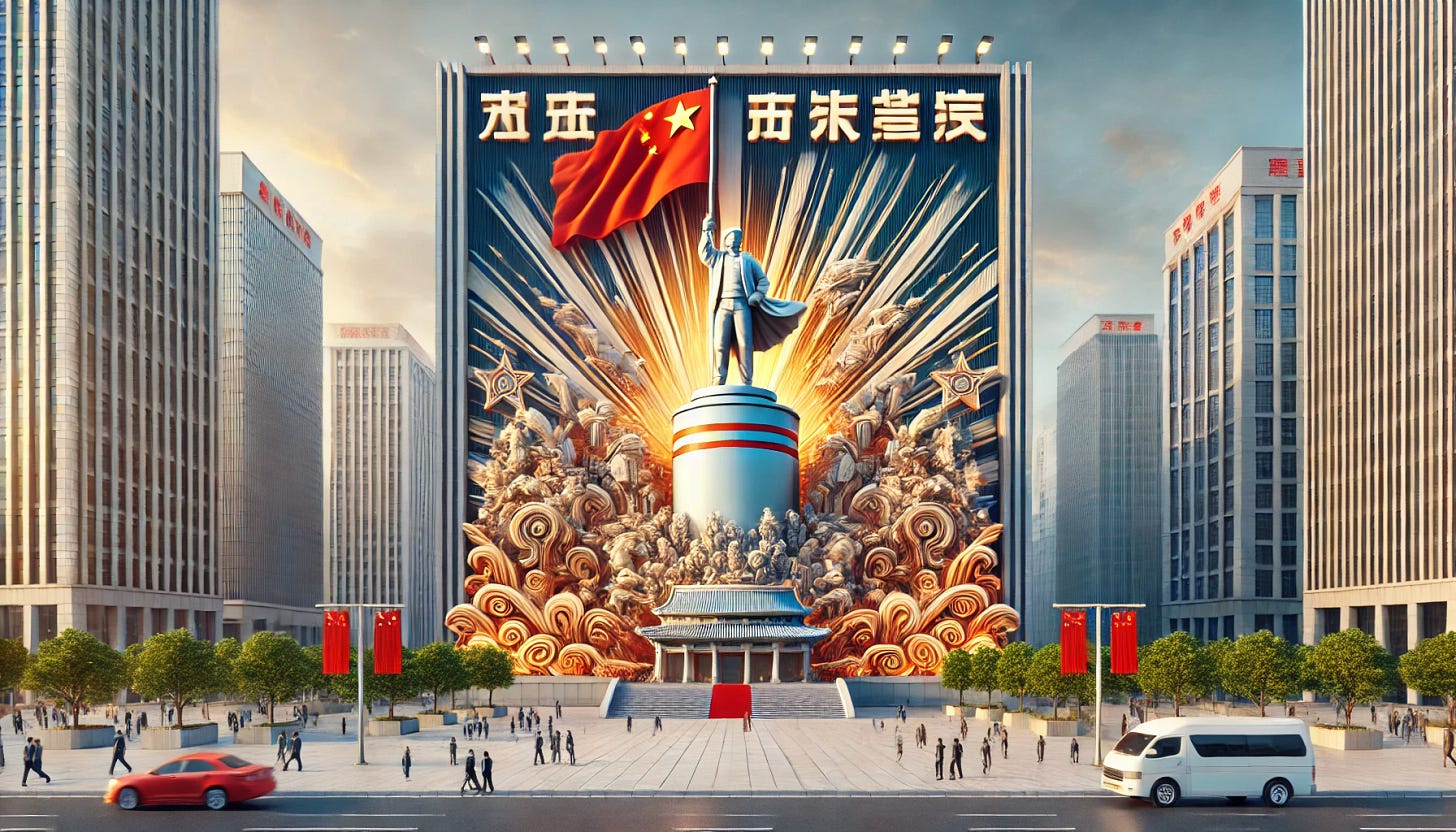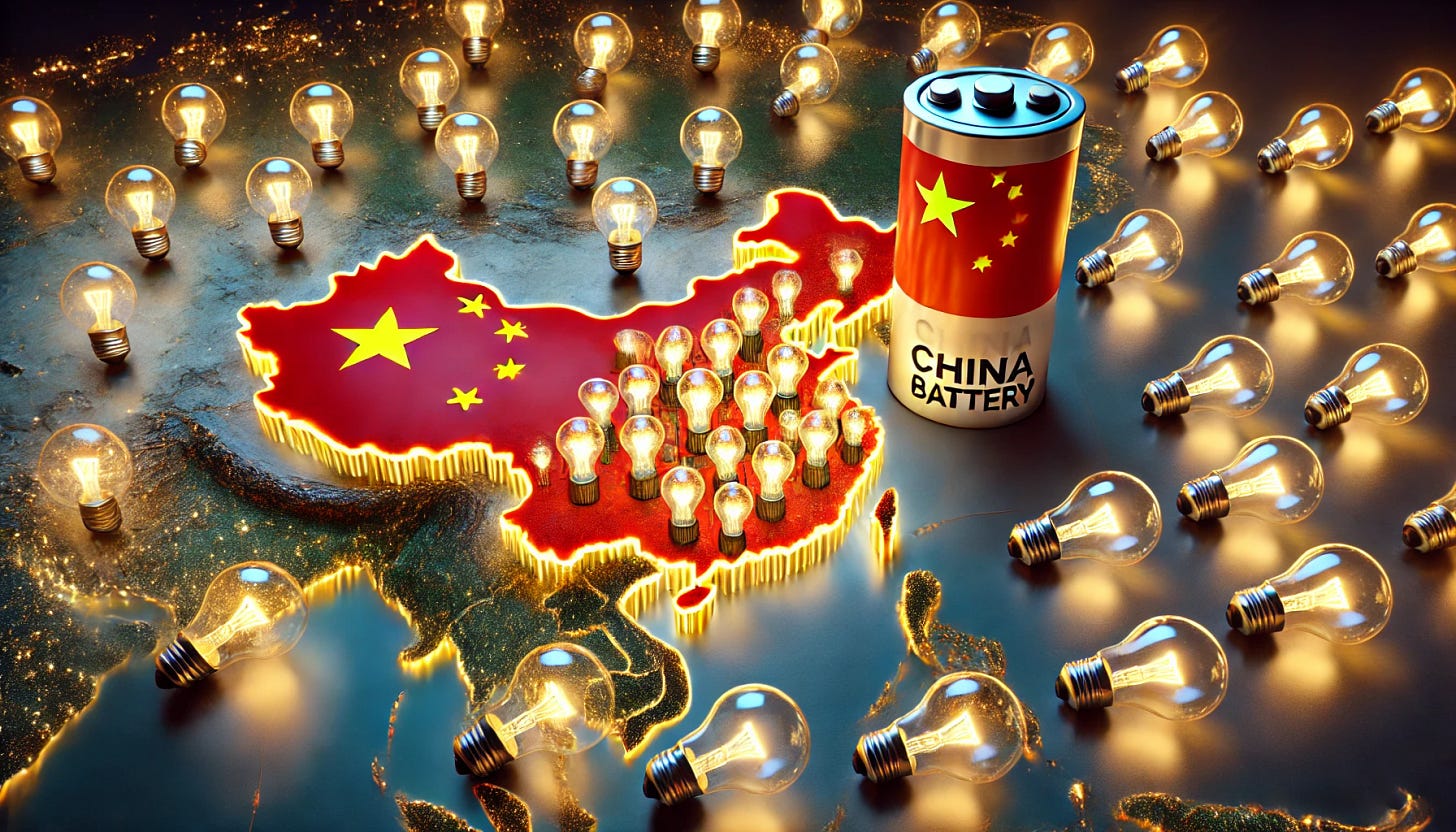Ready for a jolt?
As of today, China manufactures over 75% of the world's batteries and 80% of the cells, powering everything from smartphones to electric vehicles (EVs).
Imagine a world where electric vehicles (EVs) are the norm, renewable energy powers our homes, and portable electronics last for days on a single charge. This isn't just a dream. It's a future that China's battery industry is actively shaping.
This isn't just about staying charged. It’s about driving the future of global energy.
In this edition of Decoding the Dragon, let’s dive into the electrifying story of China’s rise as a battery powerhouse and its sweeping effects on the global stage.
Sparking the Revolution: The Early Days of China's Battery Industry
The roots of China's battery industry can be traced back to the 1990s, with a primary focus on lead-acid batteries for traditional industries and consumer electronics.
However, a seismic shift occurred in the early 2000s when the Chinese government recognized the strategic importance of lithium-ion cells for emerging areas like renewable energy, new-age electronics and mobility.
This realization sparked a concerted effort to develop and expand the battery sector.
And, the government's support came in the form of generous subsidies, investments in research and development, and favourable policies aimed at attracting foreign investment and fostering domestic innovation.
These measures, combined with China's vast manufacturing capabilities and lower labour costs, created a perfect storm for the battery industry's rapid growth.
Accelerating Forward: China's Dominance in the 21st Century
By 2010, with the rise of mobile technology, Chinese companies like CATL (Contemporary Amperex Technology Co. Limited) and BYD had started to make significant inroads into the lithium-ion battery market.
Government subsidies for EVs and renewable energy initiatives further accelerated development and drove up battery demand, positioning China at the forefront of the global market.
Chinese manufacturers capitalized on this opportunity, rapidly expanding their production capacity and investing heavily in research and development.
Thus, the 2010s witnessed an unprecedented surge in China's battery production.
The Electrifying Players: CATL, BYD, and CALB
This birthed many global titans in China, with three emerging as the most prominent ones.
CATL: It is the world's largest battery manufacturer, boasting a 37% global market share in 2023. Its clientele includes Tesla, BMW, Mercedes, Ford and Volkswagen. And its success stems from its relentless focus on staying ahead in the research and development of innovative battery technologies like its sodium-ion batteries, and its unparalleled production capacity.
BYD: Build Your Dreams (BYD) is a unique player in the industry, being both a leading EV manufacturer and a major battery supplier. BYD's Blade Battery, known for its safety and energy density, has garnered significant attention and adoption worldwide for its path-breaking range at low cost.
CALB: It is a rising star, rapidly expanding its production capacity and securing lucrative contracts with major automakers. CALB's focus on affordability and safety positions it as a formidable contender in the mass market segment.
Apart from these, there are many more players like Tianjin Lishen, which supplies batteries to niche consumer electronics and automotive industries worldwide.
These companies are at the heart of China's industrial strategy, benefiting from government policies that promote clean energy and technology exports.
Global Impact: Electrifying the World, One Battery at a Time
China’s dominance in battery production has profound implications for global supply chains.
For instance, the U.S. and European automakers are increasingly dependent on Chinese batteries for their EVs, highlighting a critical aspect of energy security and economic policy. The ripple effects of China's battery dominance are felt worldwide.
And to address this, the US has made battery development a top priority as part of its clean energy agenda.
The Bipartisan Infrastructure Law allocates substantial funds for battery research, development, and manufacturing.
American companies like Tesla and General Motors are expanding their battery production capacity, while startups like QuantumScape are pioneering next-generation battery technologies.
Meanwhile, with ambitious plans to achieve 30% EV sales by 2030, India is also heavily incentivizing domestic battery manufacturing.
The government's Production Linked Incentive (PLI) scheme has attracted big investments. And, Reliance Industries, Tata Group (Agratas), Exide, Amara Raja, Ola Electric and many more are investing heavily in battery manufacturing facilities, aiming to reduce India's reliance on imported batteries.
But, the Domination Continues
China’s massive production capacity has significantly lowered battery prices, making electric vehicles and renewable energy storage more accessible and affordable globally.
This has accelerated the global shift towards cleaner energy sources and reduced reliance on fossil fuels, even if it has raised concerns about supply chain security and potential geopolitical risks.
The concentration of battery production in one country could create vulnerabilities in the global supply chain, especially in times of political or economic instability.
The environmental impact of mining and processing raw materials for batteries is another pressing issue that requires careful consideration.
But, for now, China reigns, hard, strong and firm.
The Road Ahead: Challenges, Opportunities, and a Sustainable Future
China's battery industry is well-positioned for continued growth, but it faces challenges such as rising raw material costs, geopolitical tensions, and increasing competition from other countries.
But, to maintain its leadership position, China is investing in heavily in cutting-edge research and development, including the development of solid-state batteries, which offer higher energy density, faster charging, and improved safety.
Furthermore, Chinese firms are leading in solid-state battery development, which promises higher safety and energy density. And the outcome is that China is well ahead of the curve, with major advancements in alternate chemistries like sodium and aluminium ion cells.
Towards this, 2023 saw major policy shifts in China, with increased incentives for high-density battery technologies and recycling processes.
These innovations are set to redefine the battery sector globally.
Conclusion: A Bright and Electrifying Future
Today, China's battery industry stands as a global juggernaut. China's battery revolution is an awe-inspiring tale of technological advancement, economic growth, and environmental ambition.
In 2023, Chinese companies produced over 325 gigawatt-hours (GWh) of lithium-ion batteries, a figure that dwarfs the combined output of all other countries.
It's a testament to the country's ability to seize opportunities and lead the charge in a critical industry. And, its dominance extends across the entire battery value chain, from raw material extraction and processing to cell manufacturing and pack assembly.
And what this means is that China is not just making batteries. Instead, it’s setting the pace for the global energy future.
As we continue to decode the dragon, we'll closely monitor the latest developments in China's battery sector, providing you with valuable insights and analysis on the global implications of this electrifying journey.











Great details
Sir great details , could you please guide us to do research like this, how to do research in so much depth , please can you just teach us the process of steps.